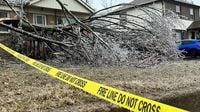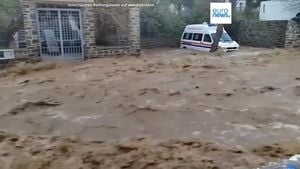Ontario residents are grappling with the aftermath of a devastating ice storm that struck the province over the weekend, leaving hundreds of thousands without power and causing significant damage to infrastructure. The storm, which began on Friday night, March 28, 2025, and continued into Sunday, March 30, coated trees, power lines, and roads in thick layers of ice, resulting in widespread outages and hazardous travel conditions.
According to Hydro One, the provincial utility, more than 380,000 customers experienced power outages at the peak of the storm. As of Sunday afternoon, March 30, the outages were concentrated primarily in central and eastern Ontario, with many residents expressing frustration over the prolonged disruptions. “I can’t imagine the lights coming back any time soon,” said Janelle Baker, a Bracebridge resident who lost power early Saturday morning. “Our driveway and our road are completely impassable at this point.”
The storm wreaked havoc across multiple communities, with cities like Orillia and Peterborough declaring states of emergency due to the severe weather. In Barrie, another city hard-hit by the storm, Alectra Utilities reported approximately 39,000 customers without power as of Sunday morning. “Most of the outages occurred starting late Friday afternoon due to the ice storm and have been ongoing through this morning,” said Lee Dapp of Alectra.
Residents described eerie scenes as the storm progressed. Susan Mair, who lives in northeast Barrie, recounted how the sound of ice breaking resembled thunder. “It’s kind of cool…as the temperature is warming, the ice is sliding off stuff like trees and roofs, and the sound of it falling all around is loud,” she said. However, many were left to contend with the consequences of the storm, including downed trees and blocked roads.
Environment Canada issued winter storm warnings for freezing rain across parts of Ontario, Quebec, New Brunswick, and Prince Edward Island, indicating that the risk of snow mixed with ice pellets would persist into Monday morning. The national forecaster warned of slippery road conditions and potential flooding in central Ontario. “Outages are largely being caused by tree limbs and branches being weighed down from the accumulation of freezing rain,” Hydro One noted on its website.
As recovery efforts began, Hydro One announced that they had restored power to over 115,000 customers by Sunday morning, but many were still left in the dark. Kelly O’Loan, a Barrie resident, described a harrowing night spent bailing out her sump pump by candlelight. “It was a very scary and treacherous night because you could hear the ice against the windows, and any time the wind blew just a little bit, you would hear things move,” she said.
The situation was compounded by reports of injuries caused by falling trees. In Georgian Bluffs, a tree fell onto a road, landing on live hydro wires and starting a fire. Provincial police urged residents to stay off the roads if possible, as melting ice created wet, slippery conditions and localized flooding. “If you’re travelling north, expect delays and detours,” warned Sgt. Kerry Schmidt.
In Kingston, the storm also led to widespread power outages, with Utilities Kingston reporting over 5,700 households affected at its peak. The freezing rain warnings remained active for most of Southeastern Ontario along Lake Ontario, as crews worked to restore power and clear debris. The City of Kingston declared a weather emergency on Friday, March 28, which continued through Sunday, leading to the closure of several municipal services and facilities.
Officials in Kingston advised residents to avoid wooded areas due to the risk of falling branches and ice. “Damaged and falling tree branches, some in the middle of roadways, as well as falling ice, pose a significant hazard,” the City stated. Cleanup efforts were expected to continue for several weeks, with priority given to clearing roadways and addressing public safety risks.
The storm's impact was felt across Ontario, with reports of nearly 70 vehicle collisions due to the icy conditions, according to the Ontario Provincial Police. Most incidents were single-vehicle collisions that resulted in no or only minor injuries. However, the sheer volume of accidents underscored the dangers posed by the storm.
As temperatures began to rise, conditions were expected to improve for southern Ontario, but northern regions continued to face challenges. An ongoing ice storm in northeastern Ontario was predicted to cause extensive tree damage and further power outages, with some areas expecting an additional 20-30 mm of freezing rain through Monday. Meanwhile, regions north of the ice, including Timmins, could see an additional 20-30 cm of snow.
As the cleanup continues, residents are left to navigate the challenges posed by the storm. Many are sharing their experiences on social media, highlighting the widespread impact of the freezing rain. “It’s just this intense creaking, and then falling,” Baker described. “It’s very eerie, almost.”
With recovery efforts ongoing, residents are urged to stay safe and remain indoors as utility crews work to restore power and clear debris. The storm has left a lasting impression on communities across Ontario, reminding everyone of the power of nature and the importance of preparedness in the face of severe weather.








